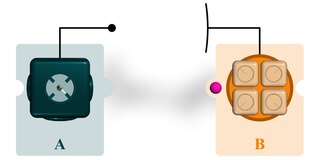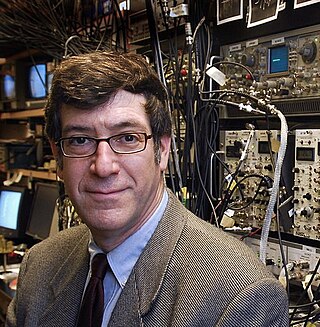Related Research Articles

Quantum teleportation is a technique for transferring quantum information from a sender at one location to a receiver some distance away. While teleportation is commonly portrayed in science fiction as a means to transfer physical objects from one location to the next, quantum teleportation only transfers quantum information. The sender does not have to know the particular quantum state being transferred. Moreover, the location of the recipient can be unknown, but to complete the quantum teleportation, classical information needs to be sent from sender to receiver. Because classical information needs to be sent, quantum teleportation cannot occur faster than the speed of light.

Quantum entanglement is the phenomenon of a group of particles being generated, interacting, or sharing spatial proximity in such a way that the quantum state of each particle of the group cannot be described independently of the state of the others, including when the particles are separated by a large distance. The topic of quantum entanglement is at the heart of the disparity between classical and quantum physics: entanglement is a primary feature of quantum mechanics not present in classical mechanics.
Quantum key distribution (QKD) is a secure communication method that implements a cryptographic protocol involving components of quantum mechanics. It enables two parties to produce a shared random secret key known only to them, which then can be used to encrypt and decrypt messages. The process of quantum key distribution is not to be confused with quantum cryptography, as it is the best-known example of a quantum-cryptographic task.
Quantum optics is a branch of atomic, molecular, and optical physics dealing with how individual quanta of light, known as photons, interact with atoms and molecules. It includes the study of the particle-like properties of photons. Photons have been used to test many of the counter-intuitive predictions of quantum mechanics, such as entanglement and teleportation, and are a useful resource for quantum information processing.

Anton Zeilinger is an Austrian quantum physicist and Nobel laureate in physics of 2022. Zeilinger is professor of physics emeritus at the University of Vienna and senior scientist at the Institute for Quantum Optics and Quantum Information of the Austrian Academy of Sciences. Most of his research concerns the fundamental aspects and applications of quantum entanglement.
In quantum information science, the Bell's states or EPR pairs are specific quantum states of two qubits that represent the simplest examples of quantum entanglement. The Bell's states are a form of entangled and normalized basis vectors. This normalization implies that the overall probability of the particle being in one of the mentioned states is 1: . Entanglement is a basis-independent result of superposition. Due to this superposition, measurement of the qubit will "collapse" it into one of its basis states with a given probability. Because of the entanglement, measurement of one qubit will "collapse" the other qubit to a state whose measurement will yield one of two possible values, where the value depends on which Bell's state the two qubits are in initially. Bell's states can be generalized to certain quantum states of multi-qubit systems, such as the GHZ state for three or more subsystems.

Charles Henry Bennett is a physicist, information theorist and IBM Fellow at IBM Research. Bennett's recent work at IBM has concentrated on a re-examination of the physical basis of information, applying quantum physics to the problems surrounding information exchange. He has played a major role in elucidating the interconnections between physics and information, particularly in the realm of quantum computation, but also in cellular automata and reversible computing. He discovered, with Gilles Brassard, the concept of quantum cryptography and is one of the founding fathers of modern quantum information theory.

Gilles Brassard, is a faculty member of the Université de Montréal, where he has been a Full Professor since 1988 and Canada Research Chair since 2001.
Claude Crépeau is a professor in the School of Computer Science at McGill University. Ηe was born in Montreal, Quebec, Canada, in 1962. He received a master's degree from the Université de Montréal in 1986, and obtained his Ph.D. in Computer Science from MIT in 1990, working in the field of cryptography with Silvio Micali as his Ph.D. advisor and Gilles Brassard as his M.Sc advisor. He spent two years as a Postdoctoral Fellow at Université d'Orsay, and was a CNRS researcher at École Normale Supérieure from 1992 to 1995. He was appointed associate professor at Université de Montréal in 1995, and has been a faculty member at McGill University since 1998. He was a member of the Canadian Institute for Advanced Research program on Quantum Information Processing from 2002 to 2012.
William "Bill" Kent Wootters is an American theoretical physicist, and one of the founders of the field of quantum information theory. In a 1982 joint paper with Wojciech H. Zurek, Wootters proved the no cloning theorem, at the same time as Dennis Dieks, and independently of James L. Park who had formulated the no-cloning theorem in 1970. He is known for his contributions to the theory of quantum entanglement including quantitative measures of it, entanglement-assisted communication and entanglement distillation. The term qubit, denoting the basic unit of quantum information, originated in a conversation between Wootters and Benjamin Schumacher in 1992.

Mark George Raizen is an American physicist who conducts experiments on quantum optics and atom optics.
Dipankar Home is an Indian theoretical physicist at Bose Institute, Kolkata. He works on the fundamental aspects of quantum mechanics, including quantum entanglement and Quantum communication. He is co-author with Partha Ghose of the popular book Riddles in your Teacup - Fun with Everyday Scientific Puzzles.
Ping Koy Lam is an Australian scientist and Professor of Physics at the Australian National University in Canberra. He is currently an Australian Research Council Australian Laureate Fellow and a work package director and program manager in the ARC Centre for Quantum Computer and Communication Technology. For his PhD thesis in 1999 he was awarded the Australian Institute of Physics Bragg Medal. He was awarded the 2003 British Council Eureka Prize for inspiring science and the 2006 UNSW Eureka Prize for innovative research.
ER = EPR is a conjecture in physics stating that two entangled particles are connected by a wormhole and is thought by some to be a basis for unifying general relativity and quantum mechanics into a theory of everything.

Gerard James Milburn is an Australian theoretical quantum physicist notable for his work on quantum feedback control, quantum measurements, quantum information, open quantum systems, and Linear optical quantum computing.

Nicolas Gisin is a Swiss physicist and professor at the University of Geneva, working on the foundations of quantum mechanics, quantum information, and communication. His work includes both experimental and theoretical physics. He has contributed work in the fields of experimental quantum cryptography and long-distance quantum communication over standard telecom optical fibers. He also co-founded ID Quantique, a company that provides quantum-based technologies.
Quantum Experiments at Space Scale, is a Chinese research project in the field of quantum physics. QUESS was launched on 15 August 2016.
Peter David Drummond is a physicist and distinguished professor in the Centre for Quantum and Optical Science at Swinburne University of Technology.
Ivette Fuentes is a Professor of Quantum Physics at the University of Southampton and Emmy Fellow at Keble College, University of Oxford. Her work considers fundamental quantum mechanics, quantum optics and their interplay with General Relativity. She is interested in how quantum information theory can make use of relativistic effects.
Natalia Korolkova is a British Russian physicist and Professor at the University of St Andrews. She works in theoretical physics and quantum information science, and the development of novel routes to scale up quantum computing.
References
- ↑ "Margaret Reid elected Fellow for work in quantum theory, including teleportation and cryptography". Swinburne University . Retrieved 15 August 2014.
- ↑ "Reid, Margaret Daphne". The Encyclopedia of Australian Science and Innovation. Retrieved 19 June 2022.
- ↑ Reid, Margaret (1984). Squeezing and quantum effects in optics (Doctoral thesis). ResearchSpace@Auckland, University of Auckland. hdl:2292/1687.
- ↑ Australian Research Council Centre of Excellence in Quantum and Atom Optics
- ↑ "Einstein vs quantum mechanics ... and why he'd be a convert today". Theconversation.com. Retrieved 14 August 2014.
- ↑ "Einstein vs quantum mechanics, and why he'd be a convert today". Phys.org. 23 December 1995. Retrieved 14 August 2014.
- ↑ He, Q. Y.; Reid, M. D. (18 December 2013). "Genuine Multipartite Einstein-Podolsky-Rosen Steering". Physical Review Letters. 111 (25). American Physical Society (APS): 250403. arXiv: 1212.2270 . doi:10.1103/physrevlett.111.250403. hdl: 1959.3/371483 . ISSN 0031-9007. PMID 24483733. S2CID 37786836.
- ↑ "Moyal Medal". Macquarie University. Retrieved 3 December 2021.
- ↑ "Public Fellows List". Australian Institute of Physics. Retrieved 3 December 2021.
- ↑ "APS Fellow Archive". American Physical Society. Retrieved 3 December 2021.
- ↑ "Margaret Reid Australian Academy of Science Profile". Australian Academy of Science. Retrieved 3 December 2021.
- ↑ "Recent Fellows". Optica. Retrieved 3 December 2021.
- ↑ "Researcher Profile | Swinburne University of Technology | Melbourne". www.swinburne.edu.au. Retrieved 13 September 2020.
- ↑ "March – Margaret Reid elected Fellow for work in quantum theory, including teleportation and cryptography – Swinburne University of Technology". Swin.edu.au. 26 March 2014. Retrieved 14 August 2014.